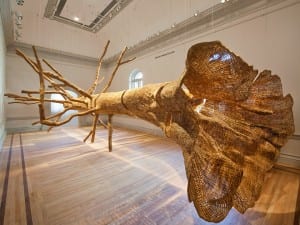Under an undulating glass canopy and a sky full of stars, violist Hank Dutt is bowing his way through the oscillations of a piece by Ottoman composer Tanburi Cemil Bey. Or is it his fellow Kronos Quartet member John Sherba on the violin next to him? Artificial intelligence algorithms tracking their facial expressions and body language can’t seem to make up their mind in projections displayed on a large screen behind the musicians. They also think Dutt is 77.6% male.
Trevor Paglen, whose Sight Machine collaboration with the innovative quartet was recently performed in Washington, thinks that’s especially sinister. Tracking the musicians in real-time using neural nets, the AI code classifies them as either male or female, in a very binary vision of the world. “If the algorithm is saying that she’s 65% female, then somebody who wrote that algorithm decided there’s such a thing as 100% female, and who is the 100% female?Is it Barbie, or is it Grace Jones or is it Angela Merkel?” Paglen asks.
But the comical errors of computer vision also earn some laughs when the video coupled with Raymond Scott’s Powerhouse tries to caption the scene. Is that a pair of scissors or a cello that Sunny Yang is holding? Is she 20 percent sad or 36 percent disgusted? In essence we are watching what machines see when they look at human interactions. The result is almost as ludicrous as the frenetic assembly lines Scott’s piece often accompanies in animated cartoons. The tone is dramatically different in George Crumb’s bone-chilling God-music from his Vietnam War protest piece Black Angels (1970), where the violinists and violists trade their instruments for a series of crystal water glasses across which they bow. As they play, an algorithm meant to track their movements between frames produces a colourful display.
Paglen doesn’t believe in progress as a concept. As someone who spends his life probing mass surveillance, data detection and government secrecy, the underbelly of technological advances is very dark indeed. “I don’t think about progress, I just think about what kinds of technologies are built to amplify what sorts of social and economic and political dynamics, and what dynamics are amplified by them and at whose expense they come,” Paglen says in an interview. “To me, that’s the question.”
Perhaps that tension is best illustrated by Different Trains, a Steve Reich composition written especially for Kronos that closes the concert. Flashing rapidly above the musicians is a series of images used to train computers (yes, it’s a pun) in recognising various objects, human movement and gestures. It’s strangely beautiful, coupled with an optimistic beat hailing the wonders of technological advances in bringing people closer together. The second movement of Reich’s piece, not played here, looks at the flipside of these advances — how Nazi Germany exploited rail infrastructure to achieve genocidal ambitions. “That’s the kind of question we leave hanging. What could possibly go wrong with Amazon, Google and Facebook collecting as much information as they possibly can?” Paglen asks.
Olivia Hampton
Sight Machine. Performed in relation to the exhibition Trevor Paglen: Sites Unseen, Smithsonian American Art Museum, Washington. Until 6 January. For more information, click here.
Travelling to the San Diego Museum of Contemporary Art (21 February – 2 June) and the Kunsthalle Wien (Autumn 2019).
Credits:
1. Trevor Paglen’s Sight Machine with Kronos Quartet and Obscura Digital. Courtesy Vimeo and Obscura Digital.




